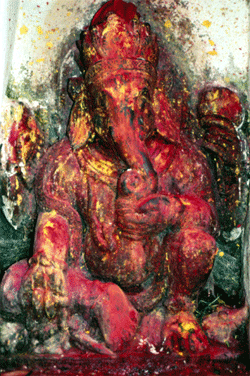Jan 05, 2026
Jan 05, 2026
The God for All Reasons
 Everybody knows the story of Lord Ganesha – perhaps, the most-favored, or favorite, of our gods. Yet, there’s more to the fascinating elephant-headed god’s tale than what meets our mind.
Everybody knows the story of Lord Ganesha – perhaps, the most-favored, or favorite, of our gods. Yet, there’s more to the fascinating elephant-headed god’s tale than what meets our mind.
The Ganesha legend is a blessing – and, for all the good reasons. Because, unlike many fairy-tales, or myths – be it Indian, or Western – with their sometimes tragic results, everybody in the story is happy.
Most of us know the story of how Ganesha celestially “evolved,” thanks to Parvati’s grace – Her little guard on duty as She goes for a bath. Her diktat: do not allow anyone, whosoever the visitor maybe. When Shiva Himself comes, He is stopped by Ganesha, who remains rock-solid even in the light of Shiva’s all-encompassing powerful presence. The rest is history.
The best part – all is well as Shiva, Ganesha’s father, gets him the famous elephant-head, and continues with His contemplation, Parvati, the mother, maintains Her sovereignty, and the son, Ganesha, lives on, “restored,” as scholar A K Ramanujan, put it, “to proximity with His mother.” In so doing, the Ganesha narrative also brings a fresh structure to the amazingly divine event – a new model of father-son and mother-son relationship for our contemporary society.
It goes without saying that Parvati used Her great powers to declare that Ganesha be raised to the level of God, and given very important tasks. Hence, Ganesha became the God in charge of removing obstacles, and also categories – a God, who plays a big part in lending a helping hand to all human endeavors. Besides, He also facilitates us in all beginnings – the beginning of a journey, a business, a job, a project, or think of what you may.
What appeals most to every devotee – from kids to grown-ups – is Ganesha’s lovely paunch. It tells us why He’s so fond of sweets! Not why He has four arms – each with a special power for an especial “favor!” The elephant in Him represents the greater Cosmos, or the macrocosm – or, all that is beyond the Moon and stars. His human body mirrors the small Cosmos, or the microcosm.
A Ganesha idol – an indispensable element of every home – depicts a human being having in one’s persona the entire Cosmos, with all its spiritual energies and authority.
Interestingly, there are other parallels to the Ganesha divinity. The closest Western “chronicle” that is analogous to the Ganesha story is Penelope and her son, Telemachus, while Odysseus is away. Telemachus is his mother’s guardian. He is her only male ally. Penelope puts her suitors – who think that Odysseus is most likely lost – off by tricking them. And, when Odysseus finally arrives, after triumphing over dangerous forces, we have a likeness to the moment of Shiva’s unexpected return to Parvati.
However this maybe, there’s a novel dimension to the Ganesha legend than any other. Ganesha stands as a doorkeeper when His mother takes bath. But, He also reflects a mother’s grieving, in the aftermath of Shiva’s homecoming. More so, because, every mother wants her son to receive a “new head,” not in the literal sense, but when what was sweet and delicious in their past together, is gone, as a “new head” is placed. Hence, when the little boy, Ganesha, receives a new elephant head, He becomes somehow a part of the Universe in a much deeper sense than before. He has, quite simply, transformed, or shifted, from the maternal realm to the social, and spiritual, world.
In a purely Indian context, Ganesha’s head symbolizes the Atman [soul] -- the ultimate, or the supreme, reality of human existence. His human body signifies maya, or illusion – the earthly existence of human beings. The elephant head signifies wisdom, and the trunk epitomizes Om – the sound emblem of cosmic reality. Ganesha also holds a goad, in His upper right hand, which helps Him to thrust mankind forward on the eternal path, and eliminate impediments on the way. What about the strap in His left hand? It is but a gentle tool to arrest all difficulties – surmountable and insurmountable.
As far as the broken tusk Ganesha holds like a “pen” is concerned, it is a symbol of sacrifice – one that He split for scripting the Mahabharata. The rosary suggests that the quest for knowledge should be constant. The sweets He holds in His trunk indicate that one must discover the everlasting sweetness of the eternal Atman. Also, Ganesha’s fan-like ears convey that He is all ears to our pleas. This is not all. The snake “encapsulating” His waist represents energy in all forms, albeit Ganesha is Himself modest enough to navigate the world astride the humble mouse.
The Ganesha story brings home an original message: that we must all do our own deeds out of inclination in our own world, and for our own reasons. Also, we must firmly hold to our own centre, without pulling our gods far out of their centre, or asking them for special “gifts” like a new car, or winning a lottery!
Reason: it’s only when devotion is observed without any ulterior motive can we purify our mind and receive God’s – in Ganesh Chaturthi’s perspective, Lord Ganesha’s – Grace.
Image (c) Gettyimages.com
09-Sep-2007
More by : Rajgopal Nidamboor

|
i believe in Him |